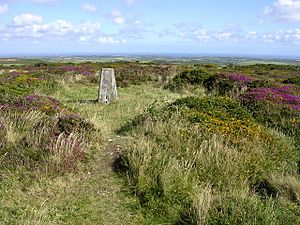Bartinney Castle facts for kids
Bartinney Castle is an ancient site from the Iron Age (a time when people started using iron tools). It is found in the Penwith Peninsula in Southwest Cornwall, England. This special place is on a hill and is surrounded by a large, circular earthwork (a bank and ditch made of earth). Around it, you can find other old remains like ancient villages, old farm fields, burial mounds (called tumuli), and cairns (piles of stones).
Just a mile southwest of Bartinney Castle is Carn Brea, which is the most western hill in Britain. About a mile to the southeast, you'll find the Carn Euny Iron Age village and its mysterious underground passage, called a fogou. Nearby are also the Caer Bran hillfort and Sancreed Beacon.
Contents
What is Bartinney Castle?
On top of the hill, you can still see parts of a circular bank and a ditch around it. This circle is about 250 feet wide. Experts think the bank might have been much taller in the past. Some believe Bartinney Castle was a special, sacred place. It might have been a Plen an Gwarry, which was like an amphitheatre (an open-air theatre). These places had rows of stone seats.
Festivals and Plays
People might have used the Plen an Gwarry for big feast days or fire festivals. These festivals often celebrated the Celtic sun god, Belenos. It's also possible that mystery plays (religious plays) were performed here.
Other Ideas
Other ideas suggest that Bartinney Castle could have been a very large disc barrow (a type of burial mound). Or, it might have been an hill fort that was never finished. The outer wall isn't tall enough to have been a strong defense. In the middle of the large circle, there were once three smaller circles. They were arranged in a triangle shape. These circles were originally made of stones, but the stones are now gone. The biggest of these smaller circles was 40 feet across. The other two were about 25 and 30 feet wide.
Fire Festivals and the Name Bartinney
Old records from the local area suggest that Bartinney Castle was a place for Celtic fire festivals. These festivals celebrated the harvest or Samhain, which was the Celtic New Year's Day.
The Meaning of Bartinè
The name "Bartinè" likely means "the lighted hill" or "the hill of fires." This comes from the Cornish word Bretanow. Long ago, the Druids (Celtic priests) were said to light fires on the evening of November 1st. People would then come to these fires to relight their own home fires. Before doing so, they had to put out their old fires.
Midsummer's Day Traditions
In more recent times, on Midsummer's Day, people in the area would hear sounds like gunshots. These sounds came from holes drilled in rocks, which were filled with gunpowder and exploded. On the same day, new flags would be put up at every mine. The night would be filled with loud parties and bonfires blazing on many hills.
The Holly Tree Connection
The name Bartinney might also come from "Tinne." This was the Druid name for the holly tree. Burning the holly tree was linked to the end of the old year and the start of the new one on Samhain, which is October 31st. Tinne also means a metal bar or iron block in an ancient Celtic alphabet called Bríatharogam.


